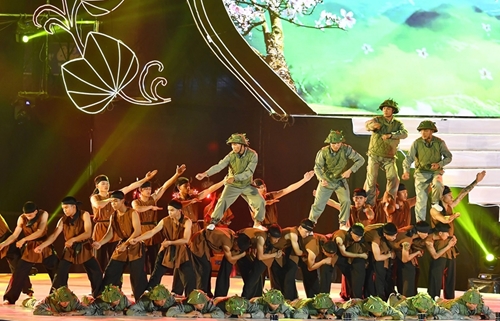70 years ago, from March 13 to May 7, 1954, under the leadership of the Party and President Ho Chi Minh, Vietnam made the Dien Bien Phu Victory that “resounded across the five continents and shook the globe.” The victory directly led to the signing of the Geneva Accords on ending the war and restoring peace in Indochina.
Before and during the campaign, along with the Vietnamese people and troops, members of the army of arts were present across the battlefield. They used not only guns, but also their “major weapons” of articles, literary works, poems, sketches, songs, and artistic performances to give more strength to frontline fighters. They followed President Ho Chi Minh’s teaching at an exhibition in 1951: “Culture and arts also make a battlefield, and artists are soldiers on that battlefield.”
    |
 |
|
An art performance during a ceremony to launch the National Tourism Year - Dien Bien and the Hoa Ban Festival 2024 |
During the 56 days of undaunted, brave, and creative fighting on the fierce battlefield, writers, reporters, composers, and painters lived together with troops in fortified trenches. They held guns, pens, and paintbrushes to reflect wartime daily life via their timely art and literary works created right on the battlefield in order to arouse a spirit of revolutionary optimism among Dien Bien soldiers.
One of them was the triumphal music of “Ho keo phao” (Ballad of hauling up the artillery pieces) by composer Hoang Van. Meanwhile, composer Do Nhuan had two famous songs “Hanh quan xa” (Marching a long distance) and “Chien thang Him Lam” (Him Lam Victory).
Notably, poet To Huu honored soldiers in the Dien Bien Phu Campaign via his immortal poem “Hoan ho chien si Dien Bien” (Bravo Dien Bien soldiers!). Besides, a number of artists like writer Nguyen Tuan, and painters To Ngoc Van, Le Huy Hoa and Ngo Ton De had many artistic works highlighting Vietnamese troops during the campaign.
Before, during, and after the Dien Bien Phu Victory, the composition and performance related to culture and arts serving local people and troops’ life were implemented continuously. Many works have become “artistic steles.”
It is clear to say that in order to gain these achievements, all members of the army of arts raised their awareness of and deeply grasped the Party’s guideline on culture and arts, closely reflected reality of life of troops and people, especially during the national resistance war against the French colonists.
Translated by Minh Anh